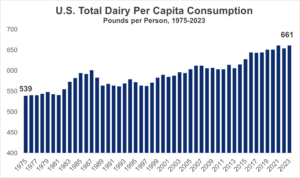Tag: dairy economics
NMPF’s Galen Explains Importance of DMC Signup in 2025
NMPF’s senior vice president Chris Galen discusses why farmers not already enrolled in the Dairy Margin Coverage program should consider using the risk management tool this year. DMC is one of several options, including Livestock Gross Margin and Dairy Revenue Protection programs, that can be used in tandem. The deadline for producers to sign up for the USDA program is Monday, March 31.
U.S. Dairy Exports Edge Higher in January; Herd Growth Resumes
Fluid Milk Sales Rise as Cheese Exports Hit Record Highs
Diving in on Dairy’s Legislative Agenda
 By Paul Bleiberg, Executive Vice President, Government Relations, National Milk Producers Federation
By Paul Bleiberg, Executive Vice President, Government Relations, National Milk Producers FederationWe know dairy is ready for an action-packed 2025. National Milk Producers Federation’s (NMPF) major legislative goals begins with passage of a five-year farm bill, but what makes up that bill for dairy is just as important.
First, enabling schools to offer whole and reduced-fat milk is paramount. Milk provides 13 essential nutrients and is the top source of calcium, potassium, phosphorus, and vitamin D for children ages 2 to 18. However, just last month, the Dietary Guidelines Advisory Committee’s Scientific Report reaffirmed that 88% of all Americans are under consuming dairy. The bipartisan Whole Milk for Healthy Kids Act, recently reintroduced in Congress, provides the solution. This bill would allow, but not require, schools to serve all varieties of milk, including whole and reduced-fat milk. A growing body of evidence demonstrates that dairy foods at all fat levels have a neutral or positive effect on health outcomes. NMPF strongly supports swift passage of this measure to solve a critical child nutrition problem.
This problem is made clearer by data. Accurate, transparent data drives strong public policymaking. And that brings up another NMPF policy priority: remedying the persistent lack of accurate data when it comes to the costs of manufacturing raw milk into processed dairy products, which denies stakeholders an essential tool for assessing how milk pricing formulas ought to be structured.
A fix lies in the Fair Milk Pricing for Farmers Act, a bipartisan bill to require USDA to conduct mandatory dairy manufacturing cost surveys every two years. This will equip all voices in the dairy industry with better data to help drive future dairy pricing conversations.
Ongoing discussions on dairy pricing are vital for an industry that continues to innovate and advance. But milk pricing isn’t the only area where innovation is necessary. On the farm, U.S. dairy farmers benefit from safe and effective feed ingredients that can boost productivity in their herds and support environmental stewardship. However, the Food and Drug Administration’s (FDA) current outdated review process for these ingredients hinders their timely approval and puts U.S. dairy farmers at a disadvantage with their global competitors. NMPF supports the bipartisan Innovative FEED Act, first introduced in 2023, to create a safe but expeditious process for FDA to review these products to help farmers make important gains and stay competitive.
These are just a handful of the major legislative efforts NMPF seeks to advance. Each of these bipartisan bills made headway last year as the House and Senate began their respective farm bill processes. With the new Congress getting ready to produce results, dairy stands ready to get these important priorities signed into law.
r of choice.
This column originally appeared in Hoard’s Dairyman Intel on Feb. 6, 2025.
Cheese, Butter and Yogurt Sales Shine as Milk Production Slips
NMPF Thanks Members, USDA for FMMO Leadership
NMPF thanked USDA and the dozens of farmers and cooperative leaders who successfully steered Federal Milk Marketing Order modernization to a successful conclusion.
“Dairy farmers and cooperatives have done what they do best – lead their industry for the benefit of all,” said Gregg Doud, president and CEO of NMPF. “This final plan will provide a firmer footing and fairer milk pricing, which will help the dairy industry thrive for years to come. We appreciate the monumental contributions across government and the dairy industry that made this happen. The industry, and all dairy consumers, owe all of you a debt of gratitude.”
The new FMMO comes after more than 200 NMPF-led meetings to formulate the proposal that contributed heavily to USDA’s final decision, as well as a record-length 49-day federal order hearing and approval from the farmers who are covered under all federal milk marketing orders.
The new federal milk-pricing system, which officially will be published in the Federal Register tomorrow, will mostly take effect June 1 – coincidentally, World Milk Day – and is closely aligned with the principles of NMPF’s member-led recommendations, a process that began nearly four years ago.
Highlights include:
- Returning the base Class I skim milk price formula to the higher-of the advanced Class III or Class IV skim milk prices for the month. In addition, adoption of a Class I extended shelf life (ESL) adjustment for all ESL products equal to the average-of mover plus a 24-month rolling average adjuster with a 12-month lag.
- Updating the Class III and IV manufacturing allowances for cheese, butter, nonfat dry milk and dry whey, and the butterfat recovery factor.
- Updating the Class I differential values to reflect the increased cost of servicing the Class I market.
- Updating skim milk composition factors, with implementation delayed six months until Dec. 1.
- Removing 500-pound barrel cheddar cheese prices from the Dairy Product Mandatory Reporting Program survey.
NMPF has more resources to understand FMMO modernization and the road taken to get there. Farmers and cooperatives will have opportunities to learn more about the new system through webinars and other materials offered in coming weeks. NMPF will also continue pushing for elements of its proposal that require congressional authorization, including mandatory dairy manufacturing cost reporting to provide accurate, transparent data to inform future milk pricing discussions.
Vitaliano’s Valedictory: Economist Shares Thoughts on Dairy’s Evolution
After nearly four decades as an economist at NMPF, Dr. Peter Vitaliano is retiring at the end of the year. He predicts a bright future for the industry.
“The U.S. dairy industry produces a huge variety of great products, for which consumption is continuing to grow,” Vitaliano said in a Dairy Defined Podcast. “It has very progressive farms and farmers, and great leadership amongst our organizations, and great organizations. That has been the case when I came, it’s the case now, and it’s going to be the case for many years in the future.”
Vitaliano, NMPF’s longtime chief economist, reflects on the evolution of policy challenges for the dairy industry in the podcast, explaining how shifts in the industry have created greater unity – and a more effective NMPF. For more of the Dairy Defined podcast, you can find and subscribe to the podcast on Apple Podcasts and Spotify under the podcast name “Dairy Defined.”
Media outlets may use clips from the podcast on the condition of attribution to the National Milk Producers Federation.
U.S. Dairy Consumption Strengthens Amid Record Retail Prices for Butter and Yogurt
Driven by Cheese, Dairy Consumption Rises Again
Propelled by record cheese use and gains in butter, cottage cheese and yogurt, U.S. per capita dairy consumption returned to 1950s levels last year, according to USDA data released just before Thanksgiving.

At 661 pounds per person, the amount of milk Americans consume is back to where it was in 2021, which in turn was on par with the year Buddy Holly died — at least in terms of dairy U.S. dairy consumption.
What’s driving the trend? Think cheese, which has doubled in per capita consumption over the past 50 years even as per capita fluid milk use has declined. Or look at butter, at its highest since the 1960s. And fermented dairy products are having a moment — cottage cheese consumption is at its highest in a decade, and yogurt is also rising.
The only disappointment? Rounding. If you drill more deeply into the numbers, 2023 didn’t quite match 2021, with consumption at 660.7 pounds, compared to 661.2 two years ago. But with positive signs in sales and the holidays ahead, there’s still a chance for Americans to push 2024 to new heights.
We can do this, America. Have your grocery carts at the ready, help a dairy farmer, and enjoy the perfect companion for your holiday cheer.





